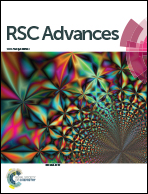Design, synthesis and biological evaluation of fluorescent ligands for MT1 and/or MT2 melatonin receptors†
Abstract
Fluorescent melatoninergic ligands have been designed by associating the 4-azamelatonin ligands with different fluorophores. The ligands show good affinities for MT1 and/or MT2 receptors and substitution of the fluorophore at positions 2 or 5 of the azamelatonin core had a direct impact on the MT receptors selectivity while grafting the fluorophores on position N1 produced fluorescent ligands with good affinities for both MT1/MT2 receptors. The optimal position N-1, C-2 or C-5 on the 4-azamelatonin ligand appeared strongly dependent upon the nature of the fluorophore itself.


 Please wait while we load your content...
Please wait while we load your content...